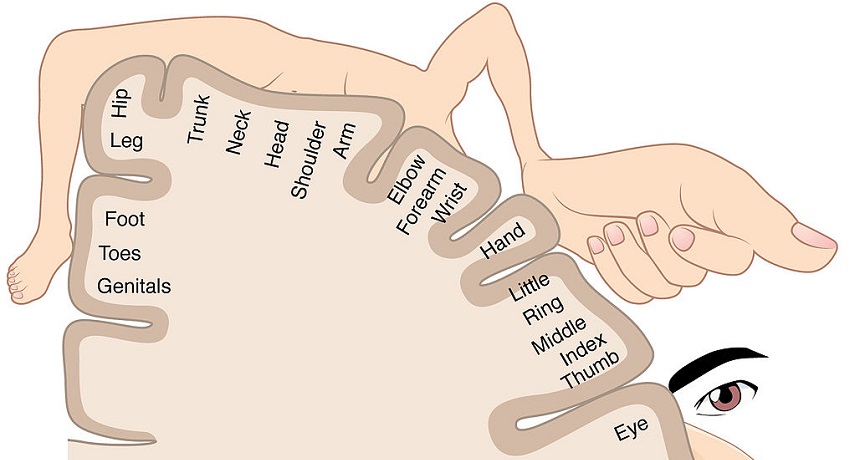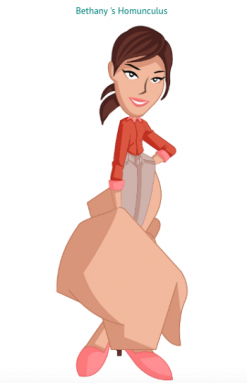A do-it-yourself map of touch
A website shows how your sense of touch maps to sites in your brain

This map shows the parts of the body next to the areas of the brain that process their sense of touch. The eyes and hands have a lot of space devoted to them; other parts, not so much.
Anatomy & Physiology, Connexions Web site. http://cnx.org/content/col11496/1.6/.
WASHINGTON – Our fingertips are very sensitive to touch, much more than are our arms or legs. Different parts of the brain respond to the touch sensations of our fingers, arms, legs and other body parts. But this can be hard to picture. An educational website now makes learning about these sensory systems and the brain easy. Anyone can do it. All you need is a friend, some toothpicks, a pen, paper and glue.
Mapping how well different parts of the body respond to touch “is an easy way to get people excited about science and thinking critically,” says Rebekah Corlew. She’s a neuroscientist at the Max Planck Institute for Neuroscience in Jupiter, Fla. Corlew came up with the idea for mapping our touch sensitivity as a way to teach students about their somatosensory cortex. That’s the area of our brain that responds to our sense of touch. She presented information on the new website November 16 at the Society for Neuroscience Meeting.
When you want to get a good sense of how soft something is, such as a cat’s fur, you touch it with your fingers, not your arm or the back of your hand. Your fingertips are far more sensitive to touch. They have more nerve endings than your arm or back. Our fingers’ high degree of sensitivity makes us able to tackle many delicate tasks, from rapid texting to surgery.
Having lots of nerve endings and a great sensitivity requires that the brain reserve more space to process all of the information arriving from that region’s nerves. So the area of your brain devoted to sensing fur on your fingertips is much larger than that responsible for sensing a bug on your leg.
These brain areas have been mapped by many scientists and portrayed as a visual map. Presented as a map on the brain, as pictured at right, it looks like a jumble of body parts laid over the cortex — the outermost layer of the brain closest to the skull. Brain areas that process touch from the thumb lie right next to those for the eye. The areas responsive to the toes are next to those for the genitals.
Many times, scientists represent the map of a physical system on a human figure called a homunculus (Ho-MUN-keh-lus). When presented as a model of a person, or cortical homunculus, each body part is scaled to the brain real estate that responds to it. In this format people look like odd puppets, with huge and sensitive hands and tongues and tiny insensitive torsos and legs.
Anyone can make a homunculus of their personal touch sensitivity. All you need is a friend to place two toothpicks on various parts of the body. Start by putting them far apart, maybe 60 millimeters (2.4 inches) apart, on your arm. Can you feel both toothpicks — or just one? Have the friend touch you again, this time with the toothpicks closer together. Do you still feel two toothpicks? Keep doing this until the pair feel like just one toothpick. Now do the same thing on other areas of the body. Stop when you only felt one poke instead of two and record the distance between the toothpicks.
As you measure different body parts, you will quickly realize that your palm can distinguish two points even when they are very close together. But your back can’t make this two-point discrimination even when the toothpicks are relatively far apart.
At this point, many high school and college classes might do some math to figure out how “big” their hand should look on their homunculus. As a general rule, if a body part detects a very small difference between two points, the area devoted to that body part on the homunculus is correspondingly huge. As the distance that can resolve two toothpicks shrinks, the brain area gets bigger. This means it is inversely proportional: As one feature grows, another shrinks in size or impact.
The inverse proportion of each body part is calculated, mathematically, as 1 divided by the smallest distance needed for two-point discrimination in the target area. So if you measured 0.375 centimeter (or 0.15 inch) as the smallest distance your hand could detect two toothpicks, the inverse proportion would be 1 divided by 0.375 — or a ratio of 2.67.

The new Homunculus Mapper website takes out the math and the graphing paper. It has you make a pair of two-point discrimination cards, using five different pairs of toothpicks. One pair is attached 60 millimeters (2.4 inches) apart. The others are 30 millimeters (1.2 inches), 15 millimeters (0.59 inch), 7.5 millimeters (0.30 inch) and 3.5 mm (0.15 inch) apart. In the last spot on the cards, place a single toothpick. Perform the two-point discrimination test with a partner. Write down the number for the smallest distance you detected two points for your hand, arm, back, forehead, leg and foot.
Now go to the website. Once you select an avatar, enter the numbers that you measured. You don’t need to find their inverse. As you select the numbers from the dropdown menus on the left of the screen, you will see your avatar change. Hands will become gigantic, while the torso shrinks. A computer program takes the measurements you enter on the site and converts them automatically. It provides an easy way to visualize how your sense of touch maps to your brain.
The site is free to use. It also comes with a full set of instructions, both for making the toothpick cards and for performing the test. In future, Corlew hopes to add an instruction video to make the process even easier.
Follow Eureka! Lab on Twitter
Power Words
avatar A computer representation of a person or character. On the Internet, this can be as simple as the picture next to your name when you send a message, or as complex as a three-dimension character in a game that moves through a virtual world.
computer program A set of instructions that a computer uses to perform some analysis or computation. The writing of these instructions is known as computer programming.
cortex The outermost layer of neural tissue of the brain.
cortical (in neuroscience) Of or relating to the brain’s cortex.
cortical homunculus The visual picture of how much space each part of the body takes up in a part of the brain known as the somatosensory cortex. It’s the area that first processes touch. It can be drawn as a series of body parts mapped onto a brain, or as a human figure with the size of each body part corresponding to its relative sensitivity.
homunculus (in science) A scale model of the human body that represents certain functions or characteristics.
inversely proportional When one value decreases at the same rate that another increases. For example, the faster you drive a car, the less time it will take to get to your destination. Speed and time would be inversely proportional.
somatosensory cortex An area of the brain critical in the sense of touch.
two-point discrimination The ability to tell the difference between two objects touching the skin very close together and only one object. It is a test used to determine the sensitivity to touch of various body parts.